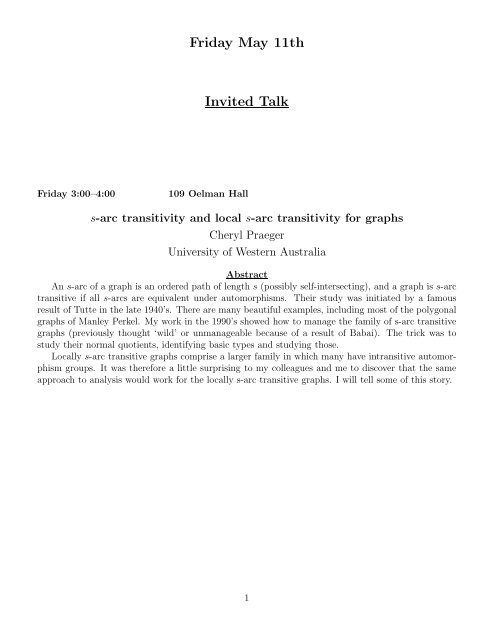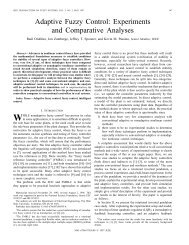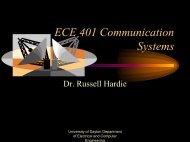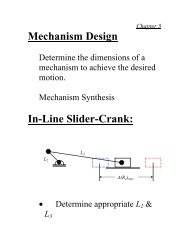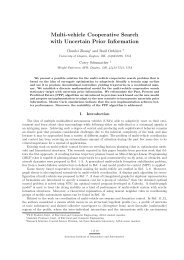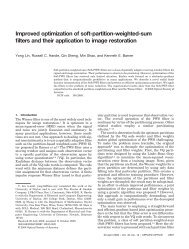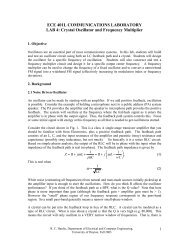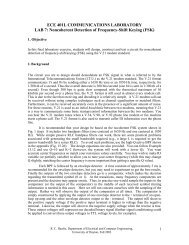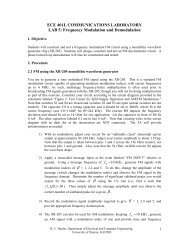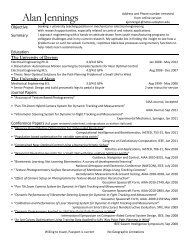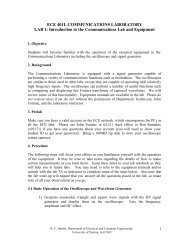here - University of Dayton : Homepages
here - University of Dayton : Homepages
here - University of Dayton : Homepages
Create successful ePaper yourself
Turn your PDF publications into a flip-book with our unique Google optimized e-Paper software.
Friday May 11th<br />
Invited Talk<br />
Friday 3:00–4:00 109 Oelman Hall<br />
s-arc transitivity and local s-arc transitivity for graphs<br />
Cheryl Praeger<br />
<strong>University</strong> <strong>of</strong> Western Australia<br />
Abstract<br />
An s-arc <strong>of</strong> a graph is an ordered path <strong>of</strong> length s (possibly self-intersecting), and a graph is s-arc<br />
transitive if all s-arcs are equivalent under automorphisms. Their study was initiated by a famous<br />
result <strong>of</strong> Tutte in the late 1940’s. T<strong>here</strong> are many beautiful examples, including most <strong>of</strong> the polygonal<br />
graphs <strong>of</strong> Manley Perkel. My work in the 1990’s showed how to manage the family <strong>of</strong> s-arc transitive<br />
graphs (previously thought ‘wild’ or unmanageable because <strong>of</strong> a result <strong>of</strong> Babai). The trick was to<br />
study their normal quotients, identifying basic types and studying those.<br />
Locally s-arc transitive graphs comprise a larger family in which many have intransitive automorphism<br />
groups. It was t<strong>here</strong>fore a little surprising to my colleagues and me to discover that the same<br />
approach to analysis would work for the locally s-arc transitive graphs. I will tell some <strong>of</strong> this story.<br />
1
Contributed Talks<br />
Friday 4:10–4:35 109 Oelman Hall<br />
Cyclic Arrangements <strong>of</strong> k-sets with Local Intersection Constraints<br />
Dan Pritikin*, Tao Jiang, and Manley Perkel<br />
Miami <strong>University</strong> <strong>of</strong> Ohio<br />
Abstract<br />
Given positive integers n, k, s with 0 < k < n, does t<strong>here</strong> exist a cyclic ordering <strong>of</strong> the k-sets <strong>of</strong><br />
{1, 2, . . ., n} such that every s consecutive k-sets are pairwise intersecting? For a given n and k, let<br />
f(n, k) denote the maximum s for which such an ordering exists. Phrased in terms <strong>of</strong> graphs, f(n, k)<br />
is the largest s such that the complement <strong>of</strong> the Kneser graph K(n, k) contains the s’th power <strong>of</strong> some<br />
Hamiltonian cycle in that complement.<br />
For each n ≥ 6 we show that f(n, 2) = 3. We show that f(n, 3) equals either 2n −8 or 2n −7 when<br />
n is sufficiently large, conjecturing that 2n − 8 is the correct value. For each k ≥ 4 and n sufficiently<br />
large we show that<br />
2n k−2<br />
(k − 2)!<br />
(7k<br />
− 2)nk−3<br />
2 −<br />
(k − 3)! + O(nk−4 ) ≤ f(n, k) ≤ 2nk−2<br />
(k − 2)!<br />
w<strong>here</strong> c is an absolute positive constant. This is a preliminary report.<br />
Friday 4:35–5:00 109 Oelman Hall<br />
(7k<br />
− c)nk−3<br />
2 −<br />
(k − 3)!<br />
Non-Cayley vertex-transitive graphs <strong>of</strong> order p k and valence 2p + 2<br />
Yuqing Chen<br />
Wright State <strong>University</strong><br />
Abstract<br />
We present a family <strong>of</strong> vertex-transitive graphs <strong>of</strong> order p k and valence 2p + 2, w<strong>here</strong> p is an odd<br />
prime and k > 3. The valence <strong>of</strong> 2p + 2 is the lowest possible for a non-Cayley vertex-transitive graph<br />
<strong>of</strong> order a power <strong>of</strong> p.<br />
2<br />
,
Friday 5:00–5:25 109 Oelman Hall<br />
Representations <strong>of</strong> Graphs modulo n: Some Problems<br />
A. B. Evans*, D. A. Narayan, and J. Urick<br />
Wright State <strong>University</strong><br />
Abstract<br />
A graph G has a representation modulo n if t<strong>here</strong> exists an injective map f : V (G) → {0, 1, ..., n}<br />
such that vertices u and v are adjacent if and only if f(u) − f(v) is relatively prime to n. The<br />
representation number rep(G) is the smallest n such that G has a representation modulo n. We pose<br />
a collection <strong>of</strong> related open problems.<br />
Friday 5:25–5:50 109 Oelman Hall<br />
Orthomorphisms <strong>of</strong> Z3 × Z9<br />
James Carter<br />
Wright State <strong>University</strong><br />
Abstract<br />
In order to study orthomorphisms <strong>of</strong> groups <strong>of</strong> the form G ∼ =<br />
n<br />
i=1<br />
Z p n i<br />
i w<strong>here</strong> the pi are not necessarily<br />
distinct, we begin with a small group Z2 × Z4. All orthomorphisms <strong>of</strong> this group are explicitly listed<br />
in Evans (1991) as found by exhaustive computer search. This data was first established by Johsnson,<br />
Dulmage, and Mendelsohn in 1961. The interesting characteristic <strong>of</strong> the group in question is its clique<br />
number, ω, which is the largest value <strong>of</strong> r for which the orthomorphsim graph admits an r-clique.<br />
The value <strong>of</strong> ω is known only for a very few classes <strong>of</strong> groups, though some bounds are known to<br />
exist for arbitrary groups. Since the number <strong>of</strong> orthomorphisms <strong>of</strong> a group with the structure <strong>of</strong> G<br />
undergoes combinatorial explosion very quickly, we first seek a pattern in a small group about which<br />
much is known, that can be extended to successively larger groups with more generalized structures.<br />
T<strong>here</strong>fore, this is an investigation <strong>of</strong> the group H ∼ = Z3 × Z9, using the homomorphic image under the<br />
mapping f((h1, h2)) = (h1, h3), h3 ≡ h2 mod 3, a pattern in Z2 × Z4, and MATLAB s<strong>of</strong>tware.<br />
3
Friday 5:50–6:15 109 Oelman Hall<br />
Non-embeddable Quasi-Derived Designs<br />
Tariq Alraqad<br />
Central Michigan <strong>University</strong><br />
Abstract<br />
A derived design <strong>of</strong> a symmetric (v, k, λ)–design D, is a 2–(k, λ, λ − 1) design D ′ obtained from D<br />
by removing a block B and replacing every other block A by A B. A 2-design that has parameters<br />
<strong>of</strong> a derived design (equivalently k = λ + 1) is called a quasi-derived design. Moreover, it is said to be<br />
embeddable if it is the derived design <strong>of</strong> a symmetric design.<br />
The main result is a method <strong>of</strong> constructing a non-embeddable quasi-derived design from a quasiderived<br />
design and an α-resolvable design. This method is a generalization <strong>of</strong> techniques used by van<br />
Lint and Tonchev (1984,1993) and Kageyama and Miao (1996). As applications, several new families<br />
<strong>of</strong> non-embeddable quasi-derived designs are constructed.<br />
Friday 6:15–6:40 109 Oelman Hall<br />
Classification <strong>of</strong> Orthogonal Arrays by Integer Programming<br />
Dursun Bulutoglu<br />
Air Force Institute <strong>of</strong> Technology<br />
Abstract<br />
In Bulutoglu and Margot (2007) the problem <strong>of</strong> classifying all isomorphism classes <strong>of</strong> OA(N, k, s, t)s<br />
is shown to be equivalent to finding all isomorphism classes <strong>of</strong> non-negative integer solutions to a system<br />
<strong>of</strong> linear equations under the symmetry group <strong>of</strong> the system <strong>of</strong> equations. In this paper a branchand-cut<br />
algorithm developed by Margot (2002, 2003a, 2003b, 2005) for solving integer programming<br />
problems with large symmetry groups is used to find all non-isomorphic OA(24, 7, 2, 2)s, OA(24, k, 2, 3)s<br />
for 6 ≤ k ≤ 11, OA(32, k, 2, 3)s for 6 ≤ k ≤ 11, OA(40, k, 2, 3)s for 6 ≤ k ≤ 10, OA(48, k, 2, 3)s for 6 ≤<br />
k ≤ 8, OA(56, k, 2, 3)s, OA(80, k, 2, 4)s, OA(112, k, 2, 4)s, for k = 6, 7, OA(64, k, 2, 4), OA(96, k, 2, 4)s<br />
for k = 7, 8, and OA(144, k, 2, 4)s for k = 8, 9. Moreover further applications to classifying covering<br />
arrays with the minimum number <strong>of</strong> runs and packing arrays with the maximum number <strong>of</strong> runs are<br />
presented. I am going to talk about these new developments regarding orthogonal arrays.<br />
4
Saturday Morning May 12th<br />
Contributed Talks<br />
Saturday 9:00–9:25 109 Oelman Hall<br />
Graph Structures and Excluded Minors<br />
John Maharry<br />
The Ohio State <strong>University</strong> at Marion<br />
Abstract<br />
In this talk, I will discuss recent research on various unavoidable minor structures in sufficiently<br />
large, well-connected graphs. T<strong>here</strong> are several types <strong>of</strong> these Ramsey-type problems. Many <strong>of</strong> these<br />
theorems are based on the ideas <strong>of</strong> tree-width, near-surface embeddings and vortex structures from<br />
Robertson and Seymour’s Graph Minors Theory. One nice conjecture in this area is that for any k,<br />
all sufficiently large 2a + 1-connected graphs must contain a Ka,k-minor.<br />
Saturday 9:25–9:50 109 Oelman Hall<br />
The maximum size <strong>of</strong> an edge cut and graph homomorphisms<br />
Ju Zhou<br />
West Virginia <strong>University</strong><br />
Abstract<br />
A k-cut l-cover <strong>of</strong> a graph H is a collection F{D1, D2, · · · , Dk} <strong>of</strong> edge cuts <strong>of</strong> H such that every<br />
edge <strong>of</strong> H lies in exactly l members <strong>of</strong> F. For a graph G, let b(G) denote the maximum size <strong>of</strong> an<br />
edge cut in G. In this paper, it is showed that if G and H are graphs such that H has a k-cut l-cover,<br />
and if t<strong>here</strong> is a graph homomorphism from G to H, then b(G) ≥ l<br />
k |E(G)|. When H = Kp/q, a result<br />
<strong>of</strong> Erdös in 1979 is generalized and proved to be best possible. When H = Kp:q, a result analogue to<br />
the result <strong>of</strong> Erdös in 1979 is got and proved to be best possible.<br />
5
Saturday 9:50–10:15 109 Oelman Hall<br />
Now<strong>here</strong> zero 4-flow in regular matroids<br />
Taoye Zhang<br />
West Virginia <strong>University</strong><br />
Abstract<br />
Let K S2<br />
5 be the graph obtained from a Petersen graph by contracting 3 edges <strong>of</strong> a perfect matching.<br />
We prove that if a coloopless regular matroid M does not have a minor in {M(K S2<br />
5 ), M ∗ (K5)}, then<br />
M admits a now<strong>here</strong>-zero 4-flow.<br />
Saturday 10:15–10:40 109 Oelman Hall<br />
Some Open Problems Involving Vertex Replacement Rules<br />
Michelle Previte<br />
Pennsylvania State <strong>University</strong> Erie<br />
Abstract<br />
Given an initial graph G, one may apply a rule R to G which replaces certain vertices <strong>of</strong> G with<br />
other graphs called replacement graphs to obtain a new graph R(G). By iterating this procedure, a<br />
sequence <strong>of</strong> graphs {R n (G)} is obtained. When each graph in this sequence is normalized to have<br />
diameter one, the resulting sequence may converge in the Gromov-Hausdorff metric to a fractal.<br />
In this talk, vertex replacement rules will be defined and examples will be given <strong>of</strong> replacement<br />
rules which yield converging and diverging normalized sequences <strong>of</strong> graphs. Also, results giving the<br />
topological and Hausdorff dimensions <strong>of</strong> the limits <strong>of</strong> vertex replacements will be presented. We will<br />
see that it is easy to constuct examples <strong>of</strong> rules which do and do not yield fractals. Finally, several<br />
open problems will be discussed.<br />
6
Saturday 10:40–11:05 109 Oelman Hall<br />
Bounding the genus <strong>of</strong> generalized n-gons<br />
Clifton E. Ealy<br />
Western Michigan <strong>University</strong><br />
Abstract<br />
A generalized polygon is a bipartite graph <strong>of</strong> finite diameter whose girth is twice its diameter. A<br />
generalized n-gon (for n at least 2) is a generalized polygon <strong>of</strong> diameter n. Generalized n-gons are<br />
examples <strong>of</strong> extremal graphs. In this talk, we will discuss upper and lower bounds for the graph<br />
theoretic genus <strong>of</strong> a generalized n-gon.<br />
Saturday 9:00–9:25 112 Oelman Hall<br />
Broadcast tree decompositions <strong>of</strong> Dn<br />
Matthew Walsh<br />
Indiana <strong>University</strong>-Purdue <strong>University</strong> Fort Wayne<br />
Abstract<br />
A broadcast tree is a directed rooted tree with all arcs directed away from the root; such a tree on n<br />
vertices is minimum if a message from the root can be propagated through the tree in at most ⌈log 2 n⌉<br />
“rounds”, w<strong>here</strong> each round consists <strong>of</strong> some or all <strong>of</strong> the vertices already in receipt <strong>of</strong> the message<br />
transmitting it to uninformed vertices via the arcs <strong>of</strong> the tree. Let Dn denote the complete directed<br />
graph, representing a network w<strong>here</strong> any participant can initiate contact with any other participant;<br />
in this talk I shall demonstrate that the arcs <strong>of</strong> Dn can be decomposed into minimum broadcast trees<br />
with distinct roots for all n > 0. Such a decomposition gives a systematic way to broadcast a message<br />
from any vertex; further, it does not require routing information to be sent with each message.<br />
7
Saturday 9:25–9:50 112 Oelman Hall<br />
Recycling Decycling<br />
Chip Vandell<br />
Indiana <strong>University</strong>-Purdue <strong>University</strong> Fort Wayne<br />
Abstract<br />
In this talk we will revisit the parameter ▽(G), the decycling number <strong>of</strong> a graph and look at how<br />
it is affected when the additional constraint <strong>of</strong> independence is put on the decycling set. In particular<br />
we will look at when decycling sets with this additional constraint exist, then find the constrained<br />
decycling number for several classes <strong>of</strong> graphs.<br />
Saturday 9:50–10:15 112 Oelman Hall<br />
DNA Codewords and De Bruijn Sequences<br />
Stephen Hartke<br />
<strong>University</strong> <strong>of</strong> Illinois at Urbana-Champaign<br />
Abstract<br />
A De Bruijn sequence is a cyclic string <strong>of</strong> length n over some alphabet S such that all <strong>of</strong> the<br />
substrings <strong>of</strong> k consecutive letters are distinct under some natural equivalence relation. Given S and<br />
k, the motivating question is to find a maximum length De Bruijn sequence. Sixty years ago, De<br />
Bruijn proved that a De Bruijn sequence <strong>of</strong> length |S| k exists when the equivalence relation is straight<br />
equality.<br />
When the alphabet is S = {A, C, G, T }, De Bruijn sequences are useful for the design and testing<br />
<strong>of</strong> DNA codewords. Since DNA can twist back on itself, we require the k-substrings to be distinct<br />
not only under equality but also reverse complementation. Results will be presented on the maximum<br />
length <strong>of</strong> a De Bruijn sequence with this equivalence relation.<br />
8
Saturday 10:15–10:40 112 Oelman Hall<br />
Infinite families <strong>of</strong> Steiner 3-designs with block size 6<br />
Niranjan Balachandran<br />
The Ohio State <strong>University</strong><br />
Abstract<br />
We generalize a construction <strong>of</strong> Hanani which produces a Steiner 3-design on a larger set <strong>of</strong> points<br />
starting from a smaller Steiner 3-design, with block size 6. We then construct several infinite families<br />
<strong>of</strong> Steiner 3-designs with block size 6. We also indicate the existence <strong>of</strong> several new Steiner designs<br />
with block size 5 as a consequence <strong>of</strong> the so-called product theorem.<br />
Saturday 10:40–11:05 112 Oelman Hall<br />
On the role <strong>of</strong> solvable groups in cage constructions<br />
Robert Jajcay* and Ge<strong>of</strong>f Exoo<br />
Indiana State <strong>University</strong><br />
Abstract<br />
Almost all <strong>of</strong> the known cages as well as the majority <strong>of</strong> the current record holders in the unsettled<br />
cases exhibit a very high level <strong>of</strong> symmetry. It is unclear, however, whether high symmetry is in<strong>here</strong>ntly<br />
a part <strong>of</strong> the game or it is simply the case that highly symmetric graphs are easier to handle. In our<br />
talk, we present results that may seem to suggest certain limitations <strong>of</strong> the use <strong>of</strong> groups in cage<br />
constructions.<br />
Our main results concern two <strong>of</strong> the most widely used constructions: Cayley graphs and voltage<br />
graphs. In each case, we will show how the length <strong>of</strong> the derived series <strong>of</strong> a solvable (finite) group<br />
G used as the underlying group <strong>of</strong> a Cayley graph or as the group <strong>of</strong> voltages gives rise to an upper<br />
bound on the girth <strong>of</strong> the resulting graph.<br />
9
Harary Memorial Lecture<br />
Saturday 11:20–12:20 109 Oelman Hall<br />
Recent results on graph searching<br />
Derek Corneil<br />
<strong>University</strong> <strong>of</strong> Toronto<br />
Abstract<br />
Searching a graph is a fundamental operation that is the cornerstone <strong>of</strong> many graph algorithms.<br />
In the early 1970s most graph searching was either Breadth First Search (BFS) or Depth First Search<br />
(DFS). Later, Lexicographic BFS (LBFS) was introduced as a simple linear time algorithm to recognize<br />
chordal graphs. Somewhat surprisingly, LBFS was largely ignored until the 1990s, when it was shown<br />
to be useful for various problems on restricted families <strong>of</strong> graphs. In particular, LBFS was applied<br />
in a multi-sweep fashion w<strong>here</strong> ties <strong>of</strong> which vertex to choose next were broken by appealing to a<br />
previous sweep. Correctness pro<strong>of</strong>s <strong>of</strong> many <strong>of</strong> these algorithms used an elegant 4-vertex condition that<br />
characterizes vertex orderings that are LBFS orderings. Since the late 1990s, many new applications <strong>of</strong><br />
LBFS have appeared. Furthermore, similar 4-vertex characterizations have been discovered for other<br />
graph searches such as BFS, DFS and Lexicographic DFS.<br />
In this talk, we will give an overview <strong>of</strong> this work, as well as a summary <strong>of</strong> open problems.<br />
10
Conference Honorees<br />
Terry McKee<br />
Following his mathematics Ph.D. in 1974 at Wisconsin, Dr. Terry A. McKee was at Western<br />
Illinois <strong>University</strong> for two years. The rest <strong>of</strong> his career has been right <strong>here</strong> at Wright State, including<br />
milestones in 1979 (promotion to Associate Pr<strong>of</strong>essor), 1981 (tenure), and 1985 (promotion to Pr<strong>of</strong>essor).<br />
Over the years, Terry’s path <strong>of</strong> scholarship has taken him from model theory in mathematical<br />
logic, the field <strong>of</strong> his doctoral studies and one <strong>of</strong> the most abstract in all <strong>of</strong> mathematics, to graph<br />
theory in discrete mathematics, one <strong>of</strong> the most readily applicable and accessible branches <strong>of</strong> our<br />
subject. His prolific record <strong>of</strong> research has produced (so far) over 100 published articles and garnered<br />
nearly a decade <strong>of</strong> funding from the Office <strong>of</strong> Naval Research.<br />
Terry is likewise a smashing success in the classroom. In fact, his outstanding teaching was recognized<br />
in awards from the College <strong>of</strong> Science and Mathematics, the President <strong>of</strong> Wright State <strong>University</strong>,<br />
the WSU Alumni Association, and SOCHE - the Southwestern Ohio Council for Higher Education.<br />
In 1991, Terry garnered the Presidential Award for Outstanding Faculty Member university-wide.<br />
Ten years later, he was tapped to become Associate Dean, a position Terry held until his midsummer<br />
retirement.<br />
Thus, Terry’s career at Wright State has spanned thirty years, throughout which he has been<br />
active and productive in research. Happily for the department that productivity will continue, and<br />
will continue <strong>here</strong>, as Terry has moved back to the department from the CoSM <strong>of</strong>fices and is banging<br />
away today on his graph theory.<br />
A telling note about the man appears on the wall <strong>of</strong> his small, windowless <strong>of</strong>fice - not the teaching<br />
awards, not the certificates recognizing his decades on the faculty, not even his Presidential Award.<br />
Instead, we see a plaque bearing his name from <strong>Dayton</strong>’s Community Blood Center, thanking him for<br />
being a ten-gallon blood donor.<br />
Manley Perkel<br />
Dr. Manley Perkel, a native <strong>of</strong> South Africa, completed his mathematics Ph.D. at Michigan<br />
in 1977. In a manner <strong>of</strong> speaking, he then followed in Terry’s footsteps, taking a faculty position at<br />
Western Illinois and thence coming to Wright State. Following his initial appointment in 1978, Manley<br />
earned promotion to Associate Pr<strong>of</strong>essor with tenure in 1985 and promotion to Pr<strong>of</strong>essor in 1995.<br />
Exemplary teaching has been a hallmark <strong>of</strong> Manley’s career from start to finish. Indeed, while he<br />
was still an Assistant Pr<strong>of</strong>essor, he won an award for outstanding teaching from what was then WSU’s<br />
College <strong>of</strong> Science and Engineering; and also in his very last years he won one <strong>of</strong> the 2005-2006 College<br />
<strong>of</strong> Science and Mathematics Outstanding Teaching Awards. A student in his Spring 2006 Modern<br />
Algebra class who heard <strong>of</strong> his forthcoming retirement wrote on an evaluation form, ”Don’t let him<br />
retire! Give him all the money he wants. Throw in a bigger <strong>of</strong>fice and a car, too.”<br />
Manley’s scholarship, focused on algebra, combinatorics, and graph theory, has taken him far and<br />
wide over the years. For example, on a six-week visit to Australia and New Zealand, he lectured at<br />
universities in Perth, Adelaide, Melbourne, Canberra, Sydney, and Auckland - and took a gigantic<br />
bungee jump along the way, the photographic pro<strong>of</strong> <strong>of</strong> which resides on his <strong>of</strong>fice wall. Moreover,<br />
11
Manley’s international outlook and expertise have led him to guest lecture three times in Regional<br />
Studies classes and the like, and in nearly twenty Spanish classes, all just in the past four years.<br />
Due to the confidence <strong>of</strong> his colleagues, Manley has filled key leadership roles throughout his tenure<br />
at WSU. As a small sample, witness his repeated election to the department’s Steering Committee, the<br />
university Academic Council, and the university Senate. Among other accomplishments, his creativity<br />
and ingenuity were critical for the university’s very creation <strong>of</strong> both the faculty rank <strong>of</strong> lecturer and<br />
the university Senate. Notably, Manley served a five-year term as department chair, having been<br />
appointment to a three-year term - all he wanted - and having been asked for two one-year encores by<br />
the dean.<br />
Manley’s activities during his retirement so far have included a special visiting appointment this<br />
past fall semester at Miami <strong>University</strong> w<strong>here</strong> he taught and pursued some new research with his<br />
collaborators t<strong>here</strong>. Beyond that, Manley tells us that his plans are less clear, though they will surely<br />
feature the international travel <strong>of</strong> which he is so fond, and may also include more teaching or research<br />
or both. We certainly hope at least some <strong>of</strong> that will occur at WSU!<br />
12
Saturday Afternoon May 12th<br />
Contributed Talks<br />
Saturday 3:00–3:25 109 Oelman Hall<br />
Graceful Labelings <strong>of</strong> Cycles<br />
Jay Bagga*, Adrian Heinz, and M. Mahbubul Majumder<br />
Ball State <strong>University</strong><br />
Abstract<br />
Rosa (1967) showed that a cycle Cn has a graceful labeling if and only if n ≡ 0(mod 4) or n ≡<br />
3(mod 4). In this paper we investigate several properties <strong>of</strong> graceful labelings <strong>of</strong> such cycles. We also<br />
present an algorithm for finding all graceful labelings <strong>of</strong> cycles, and discuss its implementation.<br />
Saturday 3:25–3:50 109 Oelman Hall<br />
An O(n 3 )-time recognition algorithm for hhds-free graphs<br />
Elaine Eschen<br />
West Virginia <strong>University</strong><br />
Abstract<br />
The class <strong>of</strong> hhds-free graphs properly generalizes the classes <strong>of</strong> strongly chordal graphs and<br />
distance-<strong>here</strong>ditary graphs, and forms a restriction <strong>of</strong> the class <strong>of</strong> perfectly orderable graphs. The<br />
problem <strong>of</strong> recognizing hhds-free graphs in polynomial time was posed by Brandstdt (Problem session:<br />
Dagstuhl Seminar No. 04221, 2004), and Nikolopoulos and Palios (Proceedings <strong>of</strong> the 31st International<br />
Workshop on Graph Theoretic Concepts in Computer Science, WG2005) gave an O(mn 2 )<br />
algorithm. We present an O(n 3 )-time algorithm for the problem. Our algorithm demonstrates a relationship<br />
between hhds-free graphs and strongly chordal graphs similar to that which is known to exist<br />
between hhd-free graphs and chordal graphs. This is joint work with Chính Hoàng (Wilfrid Laurier<br />
<strong>University</strong>) and R. Sritharan (The <strong>University</strong> <strong>of</strong> <strong>Dayton</strong>).<br />
13
Saturday 3:50–4:15 109 Oelman Hall<br />
Results on Generalized Powers <strong>of</strong> Graphs<br />
Yang Xiang<br />
Kent State <strong>University</strong><br />
Abstract<br />
We will present our results on ”Generalized Powers <strong>of</strong> Graphs and Their Algorithmic Use”. We will<br />
introduce two new types <strong>of</strong> coloring <strong>of</strong> graphs, which generalize the well-known Distance-k-Coloring.<br />
The motivation comes from the frequency assignment problem in heterogeneous multihop radio networks,<br />
w<strong>here</strong> different radio stations may have different transmission ranges. Let G = (V, E) be a<br />
graph modelling a radio network, and assume that each vertex v <strong>of</strong> G has its own transmission radius<br />
r(v), a nonnegative integer. We define r-coloring (r + -coloring) <strong>of</strong> G as an assignment Φ : V ↦→ 0, 1, 2, ...<br />
<strong>of</strong> colors to vertices such that Φ(u) = Φ(v) implies dG(u, v) > r(v) + r(u) (dG(u, v) > r(v) + r(u) + 1,<br />
respectively). The r-Coloring problem (the r + -Coloring problem) asks for a given graph G and a<br />
radius-function r : V ↦→ N ∪0, to find an r-coloring (an r + - coloring, respectively) <strong>of</strong> G with minimum<br />
number <strong>of</strong> colors. Using a new notion <strong>of</strong> generalized powers <strong>of</strong> graphs, we investigate the complexity<br />
<strong>of</strong> the r-Coloring and r + -Coloring problems on several families <strong>of</strong> graphs, such as k-chordal graphs,<br />
weakly chordal graphs, AT-free graphs, co-comparability graphs, interval graphs, circular arc graphs<br />
and strongly chordal graphs. Most <strong>of</strong> these results were obtained in collaboration with Andreas<br />
Brandstädt, Feodor Dragan and Chenyu Yan.<br />
Saturday 4:15–4:40 109 Oelman Hall<br />
Collective tree spanners <strong>of</strong> special classes <strong>of</strong> graphs<br />
Chenyu Yan<br />
Kent State <strong>University</strong><br />
Abstract<br />
We say that a graph G = (V, E) admits a system <strong>of</strong> µ collective additive tree r-spanners if t<strong>here</strong> is<br />
a system T (G) <strong>of</strong> at most µ spanning trees <strong>of</strong> G such that for any two vertices x, y <strong>of</strong> G a spanning tree<br />
T ∈ T (G) exits such that dT(x, y) ≤ dG(x, y)+r. In this talk, we give a survey <strong>of</strong> the recent results on<br />
collective tree spanners problem. In particular, we will present the results <strong>of</strong> collective tree spanners on<br />
chordal, AT-free related, homogeneously orderable graphs and graphs with bounded chrodality, tree<br />
width and clique-width. Among other results we show that<br />
• Every chordal graph admits a system <strong>of</strong> O(log n) collective additive tree 2-spanners.<br />
• Every AT-free graphs admits a system <strong>of</strong> 2 collective additive tree 2-spanners.<br />
• Every homogeneously orderable graph admits a system <strong>of</strong> O(logn) collective additive tree 2spanners.<br />
• Every k-chordal graph admits a system <strong>of</strong> O(log n) collective additive tree ⌊(k +1)/3⌋-spanners.<br />
All the above collective tree spanners can be constructed in polynomial time. This is joint work with<br />
Derek G. Corneil and Feodor F. Dragan.<br />
14
Saturday 4:40–5:05 109 Oelman Hall<br />
Logarithmic Coloring: How Hard is it to Determine Isomorphism?<br />
Christopher Augeri*, Barry Mullins, Leemon Baird, Dursun Bulutoglu, and Rusty<br />
Baldwin<br />
Air Force Institute <strong>of</strong> Technology<br />
Abstract<br />
We are interested in canonically ordering multi-dimensional data such as node positions <strong>of</strong> an<br />
unmanned aerial vehicle swarm. If we assume the data is represented by a pair-wise distance matrix,<br />
this problem is equivalent to determining graph isomorphism. Our approach to finding a canonical<br />
ordering is based on the PageRank algorithm, which sorts vertices, such as web pages, on the leading<br />
eigenvector <strong>of</strong> a perturbed adjacency matrix. The algorithm we present, IsoCanon, orders vertices by<br />
lexicographically sorting on the inverse <strong>of</strong> an adjacency matrix.<br />
Since the inverse <strong>of</strong> an adjacency matrix may not exist, we use two isomorphism-preserving perturbations<br />
that apply the Gershgorin Circle theorem to guarantee the inverse exists and so it may<br />
be efficiently obtained. To increase IsoCanon’s ability to find a canonical ordering, we also apply the<br />
necessary condition that vertices in the same orbit share the same inverse entries. We have demonstrated<br />
this algorithm terminates within a logarithmic number <strong>of</strong> iterations relative to the vertex set<br />
magnitude and finds a canonical isomorph <strong>of</strong> many random and regular graphs.<br />
We first explore how much additional information is needed to enable IsoCanon to canonically label<br />
all graphs, such as those based on Hadamard matrices. By randomly coloring a logarithmic number<br />
<strong>of</strong> vertices prior to executing the algorithm, sufficient noise is introduced to successfully identify all<br />
tested graphs. We then explore a deterministic method for coloring a logarithmic set <strong>of</strong> vertices using<br />
the matrix inverse prior to execution. This current version identifies more difficult graphs, such as<br />
Paley graphs and many posed by Mathon. The end result is the problem <strong>of</strong> determining isomorphism<br />
can be framed as ”how hard is it to make a graph easy to identify?”.<br />
IsoCanon also has three key features useful for sorting multi-dimensional data: it terminates in<br />
polynomial time, it canonically orders many graphs, and this ordering is akin to PageRank with respect<br />
to connectivity and vertex significance. IsoCanon uses parallel numerical libraries to obtain the inverse<br />
and has been extensively tested on dense graphs having up to 4,000 vertices.<br />
Saturday 3:00–3:25 112 Oelman Hall<br />
Linda Lesniak*, R. J. Faudree, and Ingo Schiermeyer<br />
Drew <strong>University</strong><br />
Abstract<br />
Let G be a graph <strong>of</strong> order n and circumference c(G). Let G be the complement <strong>of</strong> G. We prove<br />
that max{c(G), c(G)} ≥ ⌈2n ⌉ and show sharpness <strong>of</strong> this bound.<br />
3<br />
15
Saturday 3:25–3:50 112 Oelman Hall<br />
Antimagic labelings <strong>of</strong> regular bipartite graphs:<br />
An application <strong>of</strong> the Marriage Theorem<br />
Daniel Cranston<br />
DIMACS, Rutgers <strong>University</strong><br />
Abstract<br />
A labeling <strong>of</strong> a graph is a bijective function onto its edges from the set {1, 2, . . ., |E(G)|}. A labeling<br />
is antimagic if for every pair <strong>of</strong> distinct vertices u and v, the sum <strong>of</strong> the labels on edges incident to<br />
u is different from the sum <strong>of</strong> the labels on edges incident to v. We say a graph is antimagic if it<br />
has an antimagic labeling. In 1990, Ringel conjectured that every connected graph other than K2 is<br />
antimagic. The most significant progress was been made by Alon et al. (in 2004), who showed t<strong>here</strong><br />
exists a constant C, such that if an n-vertex graph G has δ(G) ≥ Cn, then G is antimagic. In this<br />
paper, we show that every regular bipartite graph (with degree at least 2) is antimagic. Our technique<br />
relies heavily on the Marriage Theorem.<br />
Saturday 3:50–4:15 112 Oelman Hall<br />
The degree-associated reconstruction number <strong>of</strong> a graph<br />
Michael D. Barrus<br />
<strong>University</strong> <strong>of</strong> Illinois at Urbana-Champaign<br />
Abstract<br />
Given a graph G, a card <strong>of</strong> G is an induced subgraph formed by deleting one vertex. The multiset<br />
<strong>of</strong> cards <strong>of</strong> G is the deck <strong>of</strong> G. The well-known Reconstruction Conjecture states that any two graphs<br />
on at least three vertices with the same decks are isomorphic; that is, the deck determines the graph.<br />
One can then define the reconstruction number rn(G) to be the minimum number <strong>of</strong> cards from the<br />
deck that suffice to determine G. We consider a variation proposed by S. Ramachandran, in which<br />
each card is presented along with the degree <strong>of</strong> the deleted vertex, yielding a “dacard.” The degreeassociated<br />
reconstruction number drn(G) is the minimum number <strong>of</strong> dacards that determine G. We<br />
describe several results on drn(G) in the cases w<strong>here</strong> G is a regular graph or a tree. This is joint work<br />
with Douglas B. West.<br />
16
Saturday 4:15–4:40 112 Oelman Hall<br />
Generalizing a theorem <strong>of</strong> Kundu<br />
Art Busch<br />
<strong>University</strong> <strong>of</strong> <strong>Dayton</strong><br />
Abstract<br />
Kundu’s Theorem states that for a graphic sequence D = (d1, d2, . . .,dn) such that (d1 − k, d2 −<br />
k, . . .,dn − k) is also graphic, t<strong>here</strong> exists a graph G with degree sequence D that contains a k-factor.<br />
In this talk we interpret this result as a problem on edge-colored complete graphs, and discuss two<br />
new generalizations.<br />
Friday 4:40–5:05 112 Oelman Hall<br />
On s-hamiltonian line graphs<br />
Yehong Shao<br />
Ohio <strong>University</strong> Southern<br />
Abstract<br />
For an integer s ≥ 0, a graph G is s-hamiltonian if for any vertex subset S ⊆ V (G) with |S| ≤ s,<br />
G − S is hamiltonian. It is well known that if a graph G is s-hamiltonian, then G must be (s + 2)connected.<br />
The converse is not true, as t<strong>here</strong> exist arbitrarily highly connected non-hamiltonian<br />
graphs. But for line graphs, we prove that when s ≥ 5, a line graph is s-hamiltonian if and only if it<br />
is (s + 2)-connected.<br />
17
Additional Abstracts<br />
Friday 4:35–5:00 109 Oelman Hall<br />
2-arc transitive polygonal graphs <strong>of</strong> high girth<br />
Ákos Seress<br />
The Ohio State <strong>University</strong><br />
Abstract<br />
A near-polygonal graph is a graph Γ with a distinguished set C <strong>of</strong> cycles <strong>of</strong> common length m such<br />
that each path <strong>of</strong> length two lies in a unique element <strong>of</strong> C. If m is the girth <strong>of</strong> Γ then the graph is<br />
called polygonal.<br />
Polygonal graphs are Manley Perkel’s invention. In his thesis, he introduced two infinite families<br />
<strong>of</strong> 2-arc transitive, near-polygonal graphs <strong>of</strong> valency 5 and 6, which are orbital graphs <strong>of</strong> special linear<br />
groups. In this talk, we report on computer searches for polygonal graphs in Perkel’s families. The<br />
largest examples we have found have girth 23 and the number <strong>of</strong> vertices is over 10 17 .<br />
18


